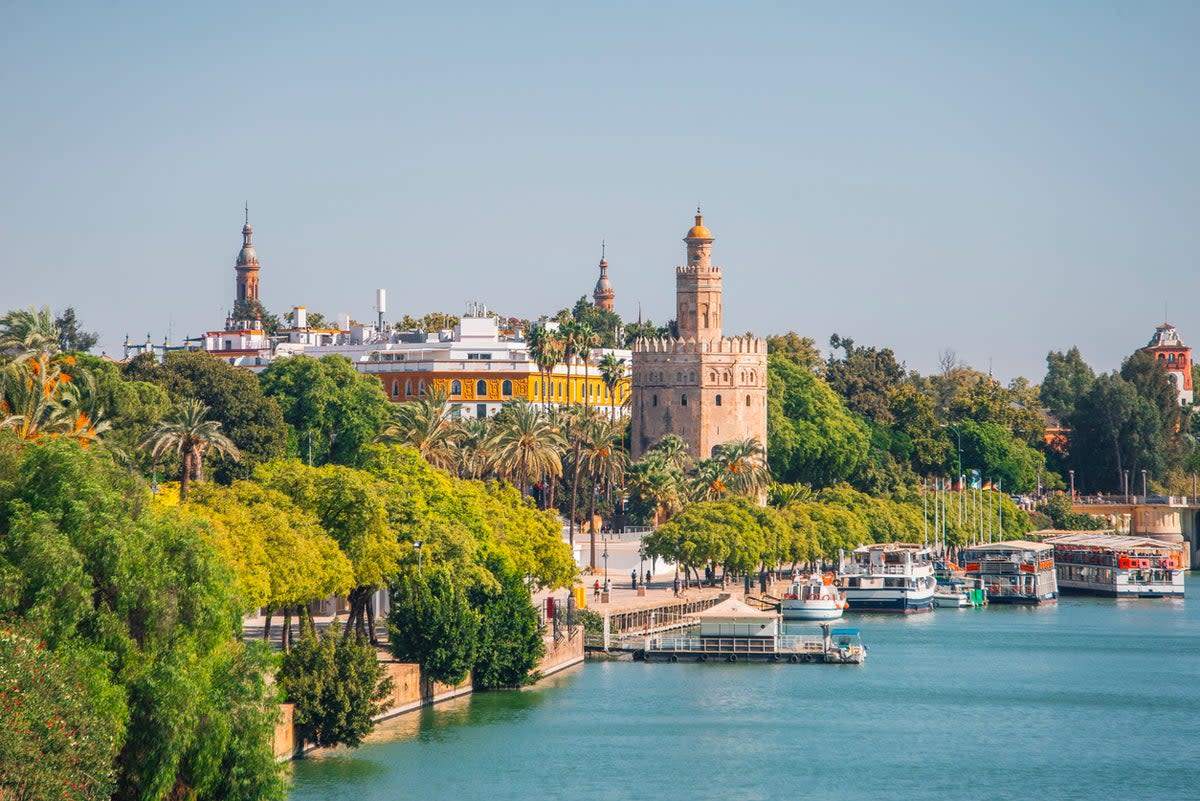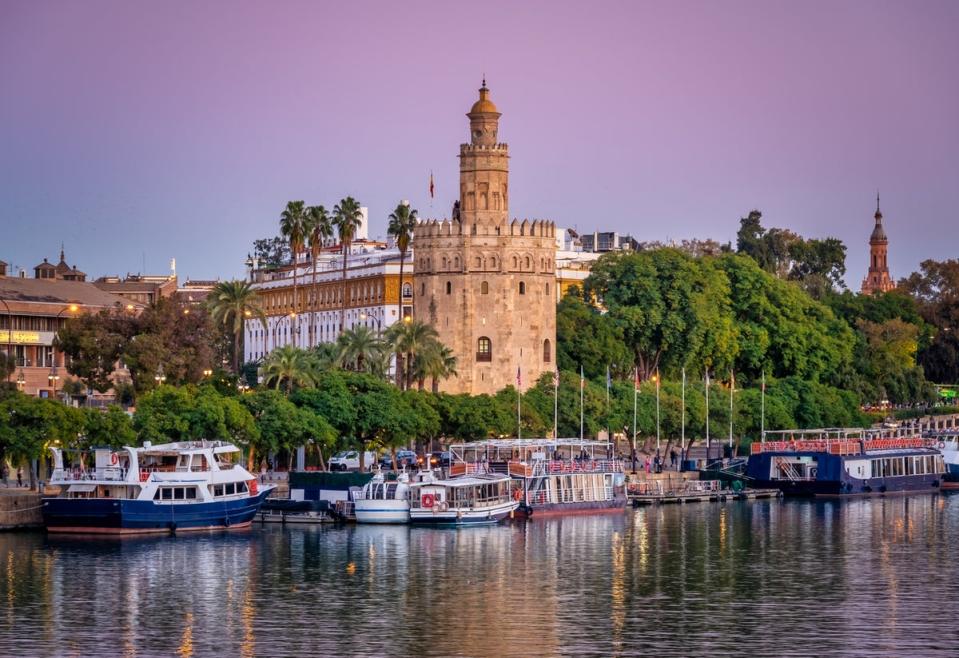10 of the best things to do in Seville

Continental Europe’s warmest city, Seville is a destination that has been on tourists’ radar for some time.
Year-round excellent weather, renowned attractions and a way of life that is exceedingly relaxed and enjoyable have made it popular with Brits, Europeans and Spaniards alike.
And unlike other cities in Spain, visitors only need to spend three days in Seville to experience its best bits; a long weekend break gives you enough time to see the headline sights, and you won’t leave feeling exhausted (unless you’ve come during the sweltering summer months).
The pre-eminent landmarks include Unesco-listed monuments, one of the world’s largest cathedrals and palaces that date back over a millennium.
A vibrant park and the banks of the Guadalquivir give the city some beautiful natural sites, while a slew of lesser-seen neighbourhoods and an abundance of cultural flair are visible in its festivals and traditions such as flamenco dancing. To help you make the most of your stay, we’ve rounded up the best things to do in the Pearl of Andalusia.
Tour the Alcazar

Despite its impressive cathedral, most will agree that Seville’s premier tourist attraction is the Real Alcazar. This palace complex, a fusion of Islamic and Christian architecture, traces its roots back to the 10th century, with several additions giving it its different Moorish, Mudejar, Gothic, Renaissance and even Romanesque features.
The complex contains several different palaces, each linked by large courtyards and extensive gardens filled with typically Andalusian plants and trees. Different palaces have different features – the Cuarto Real Alto still hosts members of the royal family when they visit Seville, while the Palacio Gotico has vaulted halls adorned with large tapestries – but the highlight is the Palacio de Don Pedro, replete with intricate tile work, beautiful arches, magnificent domes, plaster work brought from the Alhambra and even gold ceilings.
Read more on Spain travel:
Visit the Maria Luisa Park and Plaza de Espana

The 84-acre Maria Luisa park is more than just a verdant oasis that locals use to escape the summer heat (or go for runs and picnics in spring). Itself a mix of Iberian and Moorish architectural and design influences, it is another monument to the city’s history, and the various gardens and buildings within it – that were built for the Ibero-American Exposition in 1929 – are still-standing remnants that tell their own stories of the city’s history, culture and architecture.
Chief among these structures is the Plaza de Espana, a vast, borderline over-the-top plaza bisected by a canal and Venetian-styled bridges, and featuring intricate brick-and-tile pavilions and arched colonnades. Local and tourists alike spend time walking through the shaded walkways, admiring the alcoves (that depict a historical event from each of Spain’s provinces) and rowing on the canal (boats can be hired for an hour for €6 (£5).
View the cathedral and ascend Giralda Tower

The largest Gothic cathedral in the world stands upon the ruins of a Moorish mosque, a metaphor for Spain’s often tumultuous history and a reminder of the role of different religious groups in defining the Andalusian capital. It features giant, stained-glass windows, numerous examples of Gothic ornamentation, a giant gold altarpiece and even paintings from Goya and Murillo, but the highlight is probably the tomb of Christopher Columbus, held aloft by four statues of knights.
Attached to the cathedral is the Giralda bell tower, which used to be a minaret in the aforementioned mosque, and now stands at over 100 metres tall. It offers sweeping views over the city’s old Jewish quarter and the Alcazar; general entry for both is priced at €12 (£10.30).
Stroll along the river

The Guadalquivir River has played a pivotal role in the development of both Seville and Spain itself, being the only major navigable river in the country. While it once enabled trade and dramatic growth for the city, it is now a blissfully calm, scenic area that invites long walks, quick strolls from the centre and a range of river cruises.
When strolling along the banks, be sure to walk to the Torre de Oro, another of Seville’s main landmarks. Dating back to the 13th century, this 10-sided structure was built by the area’s Moorish rulers as part of the city walls, and today houses a small maritime museum and a viewing platform.
Catch a flamenco show

Andalusia is the birthplace of flamenco, and there’s no better place to see a performance than in the regional capital. It originated in the late 18th century, and has since been classed by Unesco as a masterpiece of intangible heritage. Modern-day shows combine musical acts with intense, extravagant dancing; performances are either in troupes or, in more intimate shows called tablaos, by a single performer who takes to the stage as you have dinner.
The Triana district is the centre of flamenco in Seville, and venues such as Teatro Flamenco Triana, T de Triana and La Carboneria are all popular. More centrally, Los Gallos is one of the most reputed tablaos, while the Museo del Baile Flamenco allows guests to learn about the history of the tradition before watching a performance.
Be part of the Feria de Abril

Seville is home to two different nationally famous celebrations, both with drastically different vibes. Around Easter, Semana Santa (Holy Week) makes the city a more serene, pensive and somewhat serious place, but two weeks later, the Feria de Abril (April Fair) turns almost all of Seville into a fairground. Striped tents called casetas line the streets, hosting raucous, often all-night celebrations, with regular bullfights in the vast Plaza de Toros and plenty of revellers decked out in traditional costumes. Don’t be surprised to see some residents riding around on horseback or in carriages either.
The heart of the Feria is known as the ‘Real de Feria’, and extends for 24 blocks in the area between Los Remedios and Tablado. This is where the ‘Hell Street’ amusement park is located, as well as the majority of tents; most of these are private and run by local families and businesses, but there are plenty of free-to-enter tents for visitors, including two municipal ones and one for each district of the city.
Discover more of the city

Though the historic centre of the city, a neighbourhood known as Santa Cruz, is where most of the main sights are – along with many bars, restaurants, cafes and the main shopping areas – a quick wander in any direction will take you to cobbled streets lined with locals having an extended family lunch or meeting a couple of friends for some tapas. Alfalfa and Arenal are two such barrios, bordering Santa Cruz but offering a little more peace and many of the city’s best hotels, bars and tapas joints.
For nightlife, there is one clear winner. Alameda is one of the more trendy neighbourhoods, where bars and clubs open until the early hours of the morning on the Avenida de Alameda.
For more of a local’s experience, head across the Guadalquivir to Triana. This area attracts visitors wanting to see the best of the city’s flamenco shows, as well as those wanting to pick up a ceramic souvenir in workshops around Antillano Campos street, such as Ceramica Triana.
See the Casa de Pilatos

One of Seville’s most unique landmarks is a 16th-century structure that has blended Mudejar, Baroque and Renaissance elements to create a magnificent civil palace akin to a smaller Alcazar.
At the centre lies an impressive marble courtyard, and there is access to exterior gardens, but the highlights are the intricate geometric patterns used throughout, as well as the ornate wooden features and over 100 different azulejo tile designs. Upstairs, visitors can tour some artworks belonging to the Medinaceli family. Tickets to the whole house, including the artworks, cost €12 (£10.30).
Discover a great range of art and history

Seville has a range of art to rival most Spanish cities, and the undeniable highlight is the Museo de Bellas Artes, where visitors can view works from the Middle Ages right up to the 20th century, including pieces from famed Spaniards like Velazquez and Goya.
At the other end of the scale, the city’s contemporary art gallery is the Centro Andaluz de Arte Contemporaneo, where an extensive collection of modern Hispanic works sits alongside spaces for concerts, events and temporary exhibitions.
For history buffs, two museums stand out. The Archivo de Indios contains thousands of documents relating to the Spanish Age of Discovery and the empire – including maps and letters from Columbus – while the Museum of Art and Popular Customs is dedicated to Andalusian heritage. Admission to all of the above ranges from free to €1.80.
Las Setas

Officially known as the Metropol Parasol complex, Las Setas – “The Mushrooms” – is the largest wooden structure in the world. Loved by some locals and loathed by others, it has become a modern symbol of Seville, and is a contemporary architectural highlight.
Somewhat out of place among older buildings and squares, this 28-metre tall structure now offers panoramic views over Seville from its rooftop walkways, with a market and cafe on the ground below and a museum displaying Roman and medieval artefacts in the basement.
Catch a game

For football fans, the presence of two of Spain’s major teams in the city offers great opportunities to see a match (especially as one is guaranteed to be playing in the city during most weekends in the season). Sevilla are the city’s main team, slightly more well-known and successful than their rivals, but Real Betis is a cult club, with their home games taking place at the magnificent Benito Villamarin stadium. In 2024, the La Liga season ends in late May, starting up again in mid-August.
Read our reviews of the best Spain hotels

 Yahoo News
Yahoo News 
